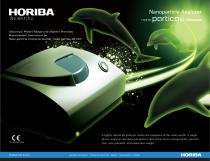
Dynamic light scattering particle size analyzer SZ-100 seriesstatic light scatteringfor water treatmentfor protein analysis

Add to favorites
Compare this product
Characteristics
- Technology
- dynamic light scattering, static light scattering
- Applications
- for water treatment, for protein analysis
- Other characteristics
- high-concentration, zeta potential
Description
A highly advanced analyzer solves the mysteries of the nano-world. A single device analyzes the three parameters that characterize nanoparticles: particle size, zeta potential, and molecular weight.
Nanotechnology research and development is a continuously evolving effort to control substances at the atomic and molecular level in order to achieve new and better materials and products. The miniaturization of components – that is, control at the nano-level – is necessary to achieve faster, higher-performance devices and functions and to reduce energy consumption. Nanotechnology has come to play a key role in wide-ranging fields that affect our daily lives, including food, cosmetics, and the life sciences.
Particle Size Measurement Range 0.3 nm to 10 µm
The SZ-100V2 Series measures particle size and particle distribution width by dynamic light scattering (DLS).
Analysis across a wide range of sample concentrations: Measurement of samples ranging from low ppm-order concentrations to high-concentration samples in double-digit percentages is possible. Accepts commercially available sampling cells. Analysis of small-volume samples is also possible.
Zeta Potential Measurement – 500 to + 500 mV
Analysis of sample volumes as small as 100 μL using HORIBA-developed microelectrophoresis cells. Use the value of zeta potential to predict and control dispersion stability. High zeta potential magnitudes indicate a stable dispersion, useful for formulation work.
Molecular weight 1 × 103 to 2 × 107 Da
Absolute molecular weight (Mw) and the second virial coefficient (A2) are obtained by performing static light scattering measurement as a function of sample concentration
VIDEO
Catalogs
SZ-100
8 Pages
Related Searches
- Microscopy
- Compound microscope
- Laboratory microscope
- Tabletop microscope
- Spectroscope
- LED illuminator
- Digital microscope
- USB microscope
- Benchtop spectroscope
- Temperature analyzer
- Fluorescence microscope
- Research microscope
- Compact illuminator
- High-definition microscope
- Polarization microscope
- Compact microscope
- Microscope illuminator
- Halogen microscope
- Calibration analyzer
- Inverted microscope
*Prices are pre-tax. They exclude delivery charges and customs duties and do not include additional charges for installation or activation options. Prices are indicative only and may vary by country, with changes to the cost of raw materials and exchange rates.






